
From upright marginals to surface floaters, aquatic plants offer seasonal interest and soften the edges of manmade ponds.
Plants provide habitat for fish and other aquatic life, improve water quality and help regulate water temperatures by providing shade. They also keep algae populations in check by competing for nutrients.
“Look to nature for inspiration on how to incorporate plants around a pond,” suggests Robert F. Brzuszek, associate professor of landscape architecture at Mississippi State University. Observe how plants of varying heights and forms grow along the water’s edge. “Some plants are better suited to shallow water and wet areas along the edge, while others need deeper water.”
“Look to nature for inspiration on how to incorporate plants around a pond.”
For year-round interest, select flowering plants, such as canna and hibiscus, that bloom from season to season. Mix in different foliage types like spiky iris with broadleaf elephant ear. “Add woody plants along the pond’s outer edges for form in winter,” says Brzuszek.
Gina Mangra, retail store manager at Aquascape, recommends hiding unsightly edges of Biofalls and other pond infrastructures like pumps with baskets of trailing plants, such as golden creeping Jenny. “You can submerge baskets right on top of the media in the Biofalls,” Mangra says.
Consider incorporating plants based on these key qualities for the waterscape. (Note: Certain aquatic plants may be considered invasive in your area, so check with your local plant expert before planting.)
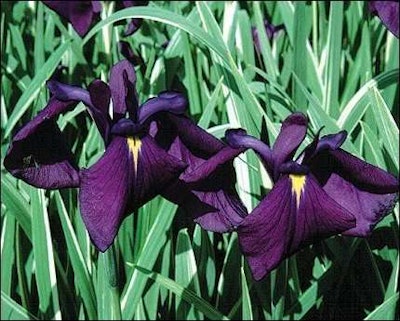 |
Variegated Japanese iris (Iris ensata ‘Variegata’). With large purple blooms in summer, the creamy white- and green-striped foliage contrasts nicely with other leafy green marginal plants. Grows to almost 3 feet tall and does best in shallow water. Hardy in USDA Zones 4 to 9. Full sun to partial shade. |
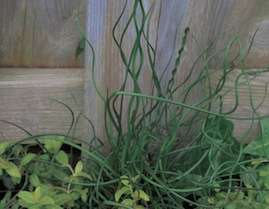 |
Corkscrew rush (Juncus effusus ‘Spiralis’). This diminutive, grass-like plant has interesting evergreen spiral-shaped stems. Stands about 1 1/2 feet tall, ideal for a shallow shelf or the forefront of a marginal planting. Hardy in USDA Zones 4 to 9(10). Full sun to partial shade. |
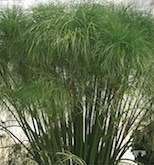 |
Egyptian papyrus (Cyperus papyrus). Adaptable for land or shallow water, Egyptian papyrus adds an interesting fine texture with its airy, green, umbel-like stems on slender stalks. Check out the 6-foot ‘King Tut’ or its miniature cousin ‘Baby Tut,’ which only reaches 2 feet tall. Hardy in USDA Zones 10 to 11. Full sun to partial shade. |
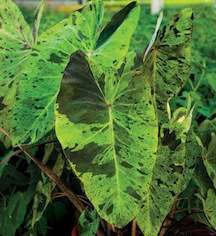 |
Elephant ear (Colocasia esculenta). Large, heart-shaped, tropical leaves atop sturdy stems are a must-have for every water garden. Newer cultivars offer dramatic chartreuse green and black mottled foliage like ‘Mojito’ or ‘Illustris’ with its more subtle frosted black foliage offset by prominent green veins. Plant along the water’s edge. Hardy in USDA Zones (7)8 to 11. Full sun to partial shade. |
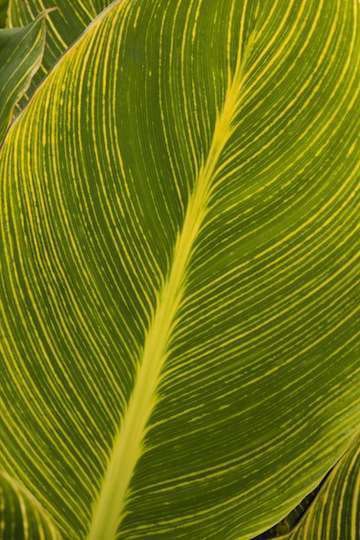 |
Canna lily (Canna sp.). Valued for its upright exotic foliage and colorful summer flowers, canna lily grows well in shallow water and reaches up to 6 feet tall. Check out ‘Tropicanna Gold’ with its gold-green striped foliage and orange-yellow flowers. Hardy in USDA Zones 7 to 11. Best in full sun; tolerates partial shade. |
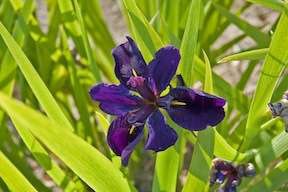 |
Louisiana iris (Iris x louisiana). This native iris offers a variety of spring bloom colors against attractive evergreen foliage. Grows to 3 feet tall and does well in shallow water or land areas prone to occasional flooding. Check out the velvety dark purple flowers of ‘Black Gamecock.’ Hardy in USDA Zones 4 to 11. Full sun to partial shade. |
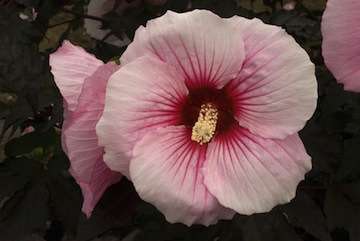 |
Swamp mallow (Hibiscus sp.) Several native hibiscus species, such as Hibiscus coccineus or H. moscheutos, grow well in shallow water and on land. Exquisite dinner-plate-sized flowers in an array of colors adorn shrubby plants. Try ‘Lord Baltimore’ with its large, scarlet red flowers on 5-foot plants or ‘Summer Storm’ with its pink flowers with rosy red eyes and contrasting purple foliage. Hardy in USDA Zones 4 to 9. Full sun. |
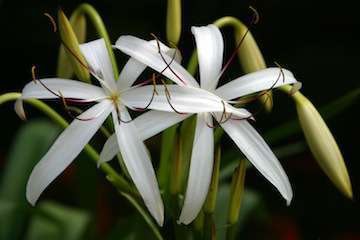 |
Bog lily (Crinum americanum). White, spider-like flowers on sturdy stalks accentuate glossy, straplike foliage. Grows to 2 feet tall. Hardy in USDA Zones 7 to 10. Full sun to partial shade. |
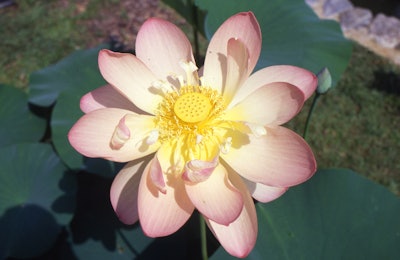 |
Lotus (Nelumbo sp.). This must-have aquatic comes in an array of flower colors against glaucous green, disk-like leaves that hover above the pond’s surface. Prefers a shallow planting depth of about 6 inches. Double-flowering ‘Mrs. Perry D. Slocum’ with its changing pink-yellow blooms has been used in ponds for years. Hardy in USDA Zones 4 to 11. Full sun. |
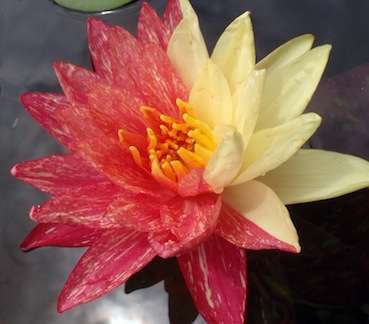 |
Waterlily (Nymphaea sp.). The stalwart of the water garden, waterlilies have characteristic leaf pads that float on top of the water. Hardy and tropical selections are available in a variety of flower colors. They can be placed in slow moving water at a depth of up to 18 inches. Check out ‘Tanzanite,’ a tropical selection with striking blue flowers or ‘Wanvisa’ (shown here), an award-winning, hardy waterlily with stunning salmon-pink and cream streaked flowers and variegated pads. Hardy selections are hardy in USDA Zones 3 to 10. Full sun. |
~~by Susan Morgan










